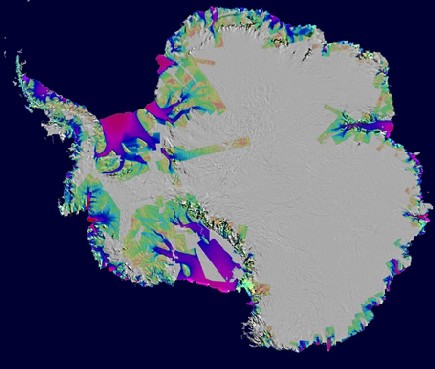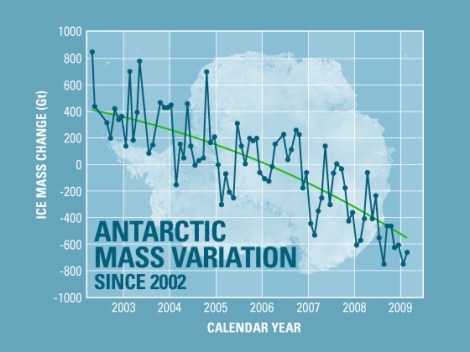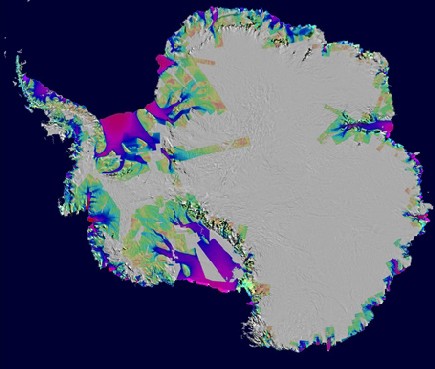We’ve talked a lot about how quickly the Arctic ice is melting. Yesterday, ye olde Grist List shared a photo of pooled water from melted ice at the North Pole. (If you would like an up-to-the-minute view of North Pole ice, the NOAA has you covered. If the camera appears to be submerged in ocean water surrounded by ice cubes, please call 311.)

Antarctic ice loss. Red indicates more loss; green, less. (Image courtesy of NASA.)
As you may recall from school / globes / common sense, the Earth has another region of frozen desert — and the Antarctic isn’t doing much better, ice-loss-wise. From Climate Central:
Scientists are intrigued with this corner of the world because it’s warming faster than anyplace else on Earth. The planet as a whole has heated up by about 1.3°F since 1900, but on the peninsula, it has shot up by a whopping 5° in just 50 years, forcing massive ice shelves to disintegrate and penguin colonies to collapse.
Heat trapping greenhouse-gas emissions are the obvious culprit, since they’ve increased dramatically over that same 50 years, but scientists prefer hard evidence to presumption, so a team from the British Antarctic Survey has been drilling into ancient ice to see how the current warming stacks up against what happened in the ancient past. If the kind of warming happening now also happened before we started burning fossil fuels, it would cast doubt on the human contribution.
What the scientists discovered, however, removed any doubt. …
“Asking whether it’s natural or caused by humans is silly,” said Eric Steig, of the University of Washington, who wrote a Nature commentary on the new research. “We’ve changed the atmosphere so dramatically that it has to be mostly human. The only question,” he said in an interview, “is how large the human influence is relative to other things.”
That warmer air, Steig continues, leads to ice shelf disintegration.

Image by NASA.
NASA — which I guess knows about things more than just space? — agrees, pointing out that while Antarctica is seeing reduced surface melt, it’s losing more ice.
The disintegration [of the Larsen B ice shelf]… was dramatic: it took just three weeks to crumble a 12,000-year old ice shelf. Over the next few years, satellite radar data showed that some of the ice streams flowing behind Larsen B had accelerated significantly, while others, still supported by smaller ice shelves, had not 9. This dynamic process of ice flowing downhill to the sea is what enables Antarctica to continue losing mass even as surface melting declines.
Antarctica can be divvied into two sections. The eastern portion is a massive block of ice sitting on a continent the size of Australia. It’s losing mass less rapidly than the western portion, which is above a series of islands akin to Hawaii. If the western section were to melt entirely, it would raise see levels by 16 to 23 feet. If the eastern portion melted? Sea levels would rise by 20 stories.
Worth pointing out: This is neither imminent nor likely. The loss of Antarctic ice mass is real, and our fault — but on the plus side, it will give Santa a place to relocate to for a while.



